100 Discovery Way, Unit 110, Acton, MA 01720 US.
Mon-Fri, 8:00 AM - 5:00 PM (GMT-5)
Die Protection Reinvented!
The Best Just Got Better. Again.
Wintriss Controls Group - the leader in Die Protection - is excited to announce a new suite of SmartPAC PRO features that represent the greatest advance in die sensor monitoring technology in more than 30 years. These new features not only expand the capabilities of the SmartPAC PRO DiProPAC, they make sensor monitoring more forgiving, enable higher production rates for hand-fed jobs, and allow complex monitoring of intermittent events without cumbersome work-arounds; all without sacrificing the SmartPAC Pro's legendary ease-of-use.
There are total of 10 new features and capabilities:
1. The Green Flex Sensor Type
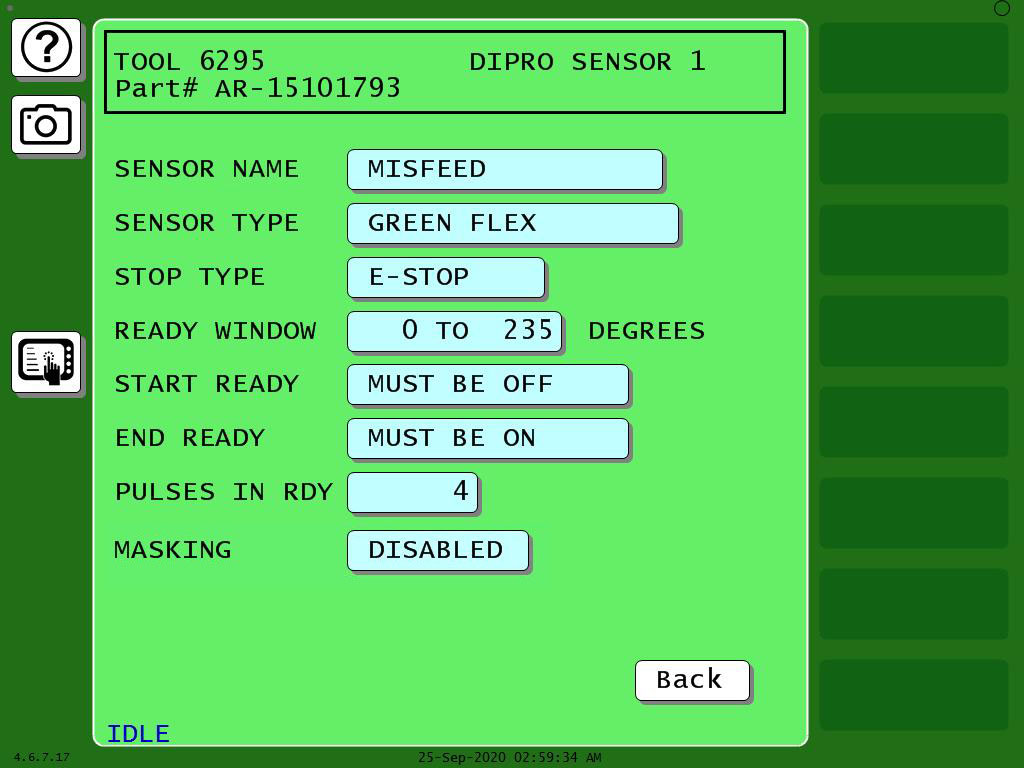
Green Flex Sensor Settings
We have created a versatile new cyclic sensor monitoring type called the Green Flex. In addition to the standard green (cyclic) sensor requirements - i.e. it must turn on sometime during the ready signal and turn off somewhere outside the ready signal - there are four new conditional options:
- You can specify the required state of the sensor at the start of the ready window. The choices are "Sensor must be ON", "Sensor must be OFF", or "Sensor can be either ON or OFF".
- You can specify the required state of the sensor at the end of the ready window. The choices are "Sensor must be ON", "Sensor must be OFF", or "Sensor can be either ON or OFF".
- You can set the sensor to require a specific number of actuations inside the ready window. You have the option of requiring either the exact number of actuations (pulses) specified, or at least the number of pulses specified.
- The masking feature (described below) is included for the Green Flex.
2. Masking for Green Sensor Types
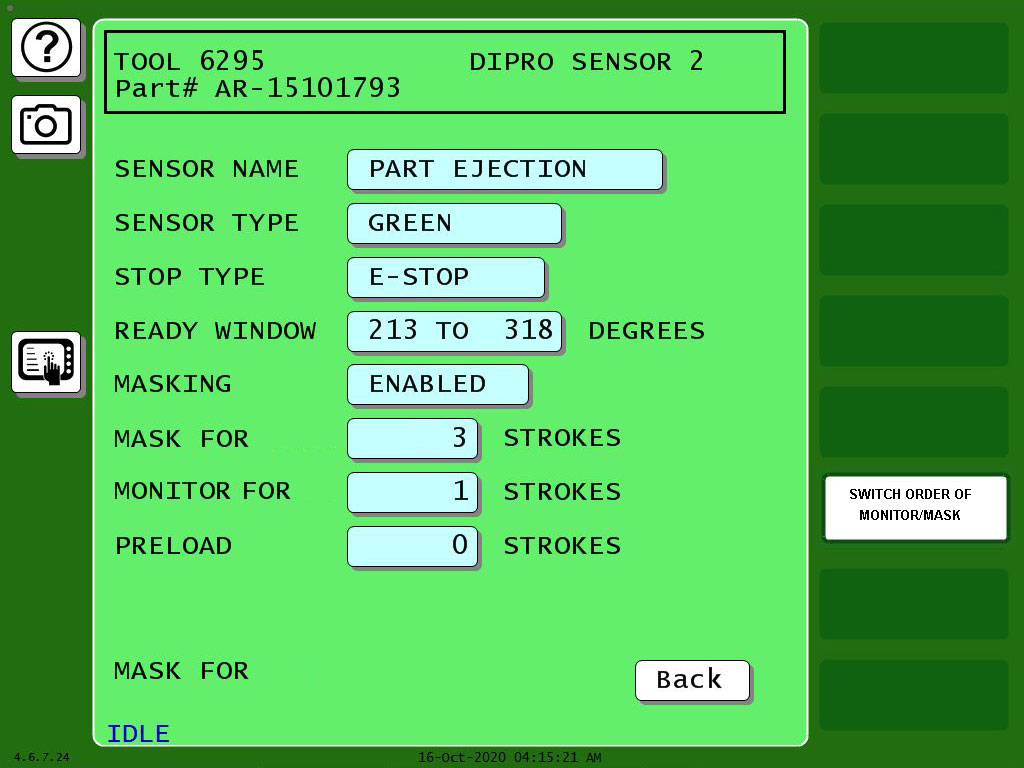
Green Sensor with Masking Enabled
Applications that use gagging, zig-zag feeds, or where multiple cycles are needed to produce a part have one thing in common: They feature die protection events that need to be monitored on certain cycles and ignored on others. A new "masking" feature is available on all green sensor types (except the Green Special).
Here is an example of how the masking feature might be used (refer to the screen shot below):
A part requires four press cycles to be produced. On the 4th cycle, a cutoff punch is gagged in, and the finished part is cut off the strip
and falls onto a conveyor. The part ejection sensor detects the part as it drops onto the conveyor during the upstroke. If an unmasked standard
Green sensor type is used for this application, it would generate an error on three out of four cycles, so masking is required.
The ready signal is set to ON @ 213° and OFF @ 318°, and the sensor is set to emergency stop the press when a fault is detected. Masking is enabled, and the SmartPAC PRO will mask the sensor for three strokes, and monitor it on the 4th to verify part ejection.
3. Bypass Windows for Red & Yellow Sensors
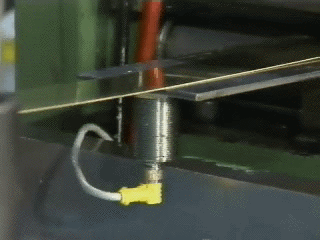
"Red" Material Buckle Sensor
The inductive proximity sensor in the animation above is being used to detect material buckle. It's a static, normally closed (a.k.a. Red) sensor. When the strip feeds normally, it stays in the sensor's sensing field, and the sensor stays actuated.
As you can see in the animation, the strip "jumps" off the sensor when the die opens. Occasionally, the strip jumps high enough to leave the sensing field which results in a nuisance stop. This is a true nuisance stop - no buckle exists - the material isn't feeding when it occurs, and the strip quickly returns to the proper position. To prevent nuisance stops for this and similar applications, the SmartPAC PRO has the ability to ignore Red and Yellow sensor actuations during a user-specified timing window called a "Bypass Window".
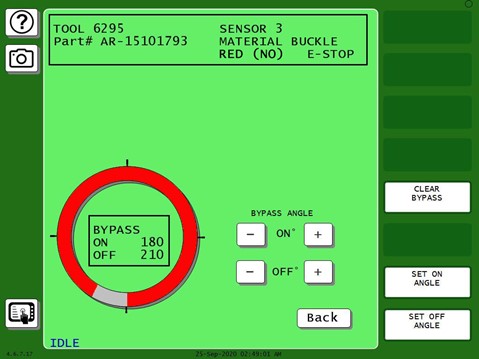
Red Sensor with Bypass Window Programmed
The screen shot above shows the material buckle sensor programmed with a bypass window that will enable it to ignore false actuations during the gray shaded area.
4. Minimum Actuation Time for Red & Yellow Sensors
The Bypass Window (described aboveis effective when you know the approximate angle during which a nuisance fault can occur. For applications that experience nuisance faults on static sensors at random times during the stroke, we have added a "Minimum Actuation Time" for the static sensors. This feature enables the DiProPAC to ignore short actuations of static sensors but will stop the press when a fault persists for longer than the specified minimum actuation time. The value can be set from 10 to 2500 mSec.
5. Auto Reset for Red & Yellow Sensors
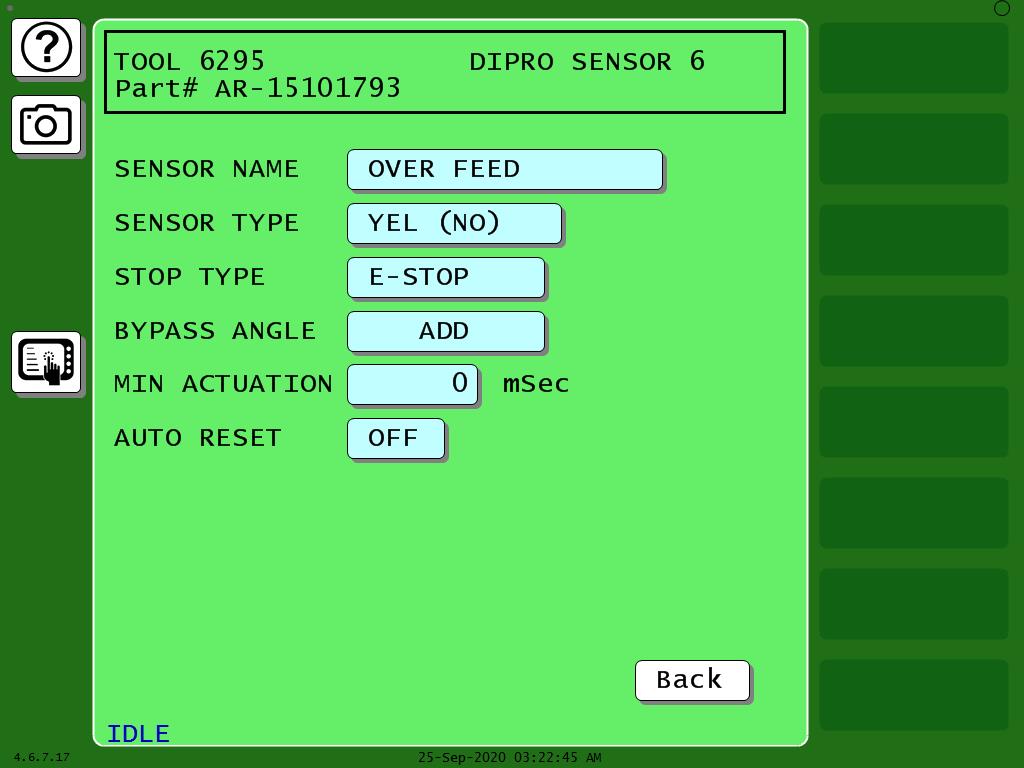
Static Sensor Summary Screen Showing Auto-Reset, Minimum Actuation Time, and Bypass Selections
Many hand-fed operations use Red (normally closed) sensors to ensure the part is properly placed in the die. When the part is in place, the Red sensors are "On", and the press is allowed to run. However, each time the operator removes the finished part, a fault occurs, requiring the operator to reset the error on every stroke. This isn't really an error; it's a normal part of the operation.
For such applications, an "Auto-Reset" function has been added to the static sensors. When Auto Reset is enabled for a sensor, the error is automatically cleared when the sensor input is appropriately satisfied. Under the scenario described above, the sensor would display a fault (and the stop relays would open) when the operator removes the part, but would automatically reset the fault (and close the stop relays) when the new part is properly in place - negating the need for the operator to press Reset before stroking the press.
6. Sensor Enable Mode Selectable by Tool
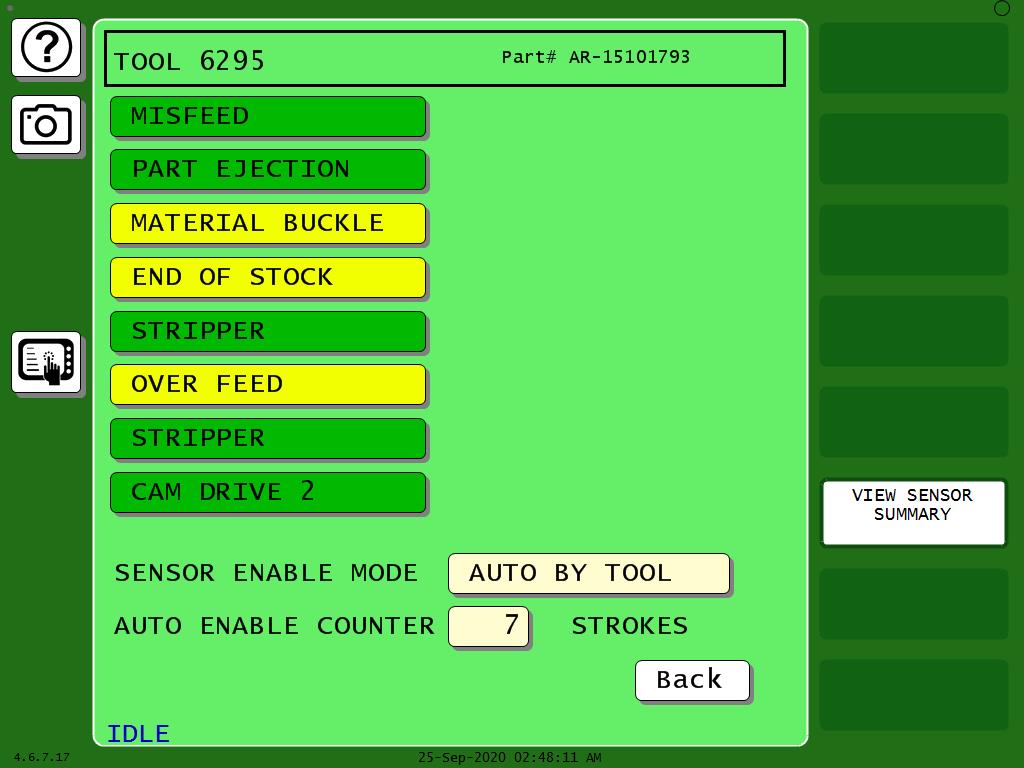
Static Sensor Summary Screen Showing Auto-Reset, Minimum Actuation Time, and Bypass Selections
The SmartPAC PRO has three sensor enable modes: Manual Enable/Disable, Auto Enable by Tool, and Auto Enable by Sensor. In previous versions of SmartPAC PRO firmware, this was a global initialization setting - all tools used the same enable mode. This can now be changed and set by tool in the programming mode.
7. Unlimited Custom Sensor Names
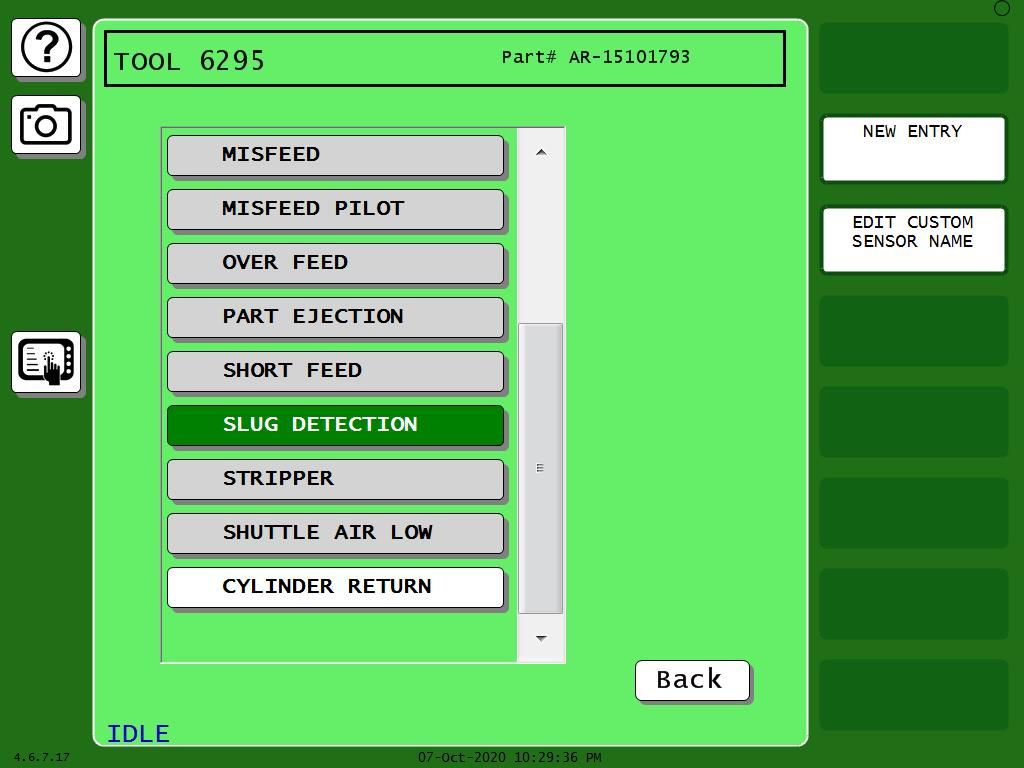
Static Sensor Summary Screen Showing Auto-Reset, Minimum Actuation Time, and Bypass Selections
Good descriptive sensor names are important for rapid troubleshooting when the die protection system detects a fault. The SmartPAC PRO now allows for unlimited custom sensor names. Names can be created on-the-fly while programming, and once created, can be added to the master list to be available for all setups, or applied only to the current tool.
8. Startup Counter for Green Special Sensors
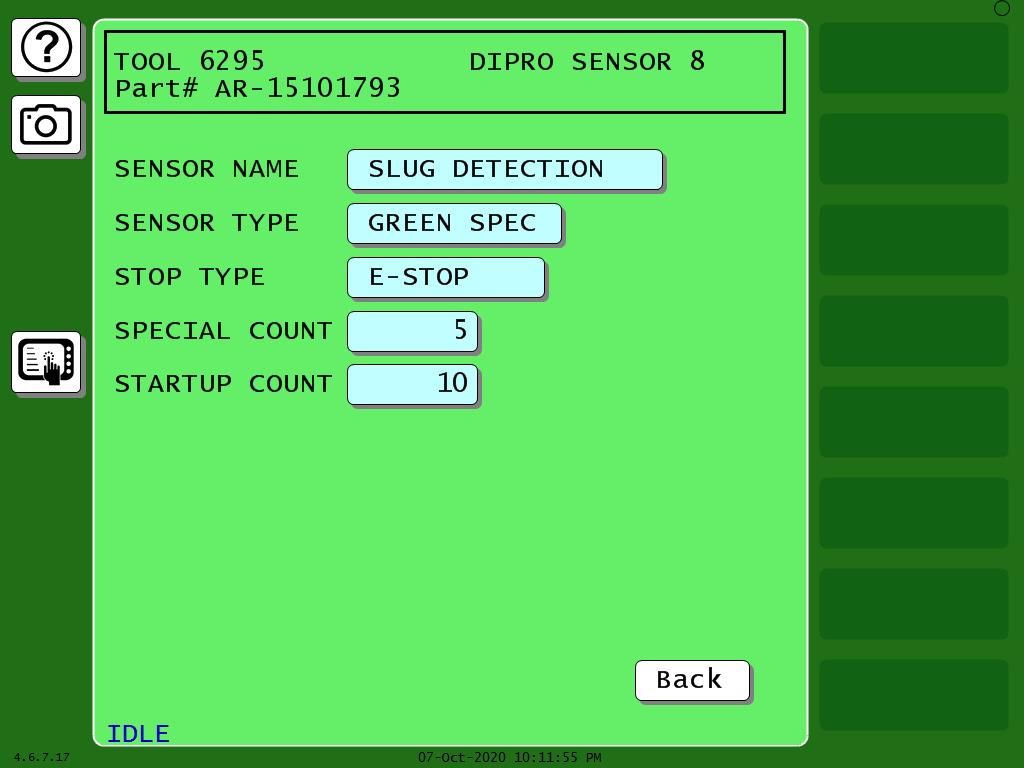
Static Sensor Summary Screen Showing Auto-Reset, Minimum Actuation Time, and Bypass Selections
The Green Special sensor type is used for detecting intermittent events such as slug ejection through the bottom die. Instead of a timing window, a counter is used to specify the maximum number of strokes allowed between sensor actuations. For dies built with "chokes" to hold slugs, it can take a number of strokes to "fill up" the choke, after which the slugs drop out more frequently. Users were faced with either nuisance stops at startup if the counter value was set to the optimum value, or using a higher than optimum counter value to account for the choke filling up at startup.
We've now added a startup counter to the Green Special sensor that can be set to a higher value at startup, then switches to an optimum value while running.
9. "Copy Sensor" Button
The Copy Sensor button allows you to quickly program a new sensor input by duplicating the settings of previously programmed sensor. This function is extremely useful in applications such as transfer monitoring or stripper detection at BDC where a large number of sensors will use the same sensor type, stop type, ready signal timing, masking, and other settings.
10. Additional "Sensors Disabled" Indicators
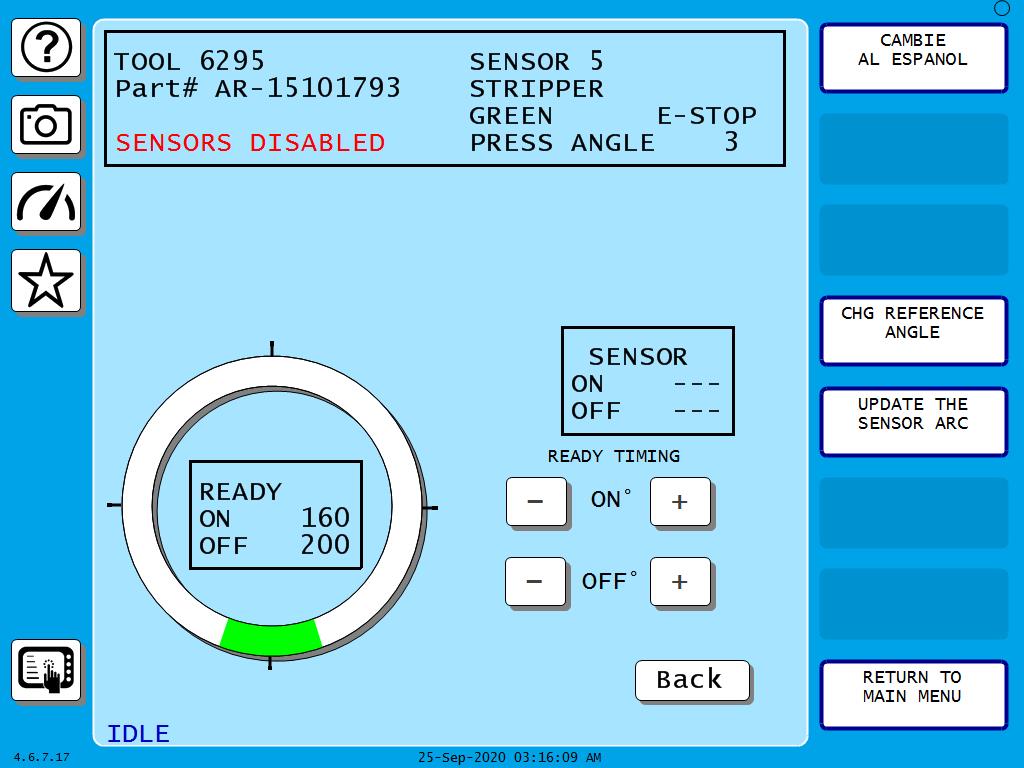
Static Sensor Summary Screen Showing Auto-Reset, Minimum Actuation Time, and Bypass Selections
When a sensor or all sensors are disabled, the SmartPAC PRO would flash a red SENSORS DISABLED indication on the main run screen. We've now added this indication to ALL the die protection screens in the run mode.
Die Protection Sensors: Photoelectric, Fiberoptic and Proximity
Wintriss offers a complete line of die-protection sensors for in-die use. These sensors are rugged,
shock-resistant and sealed against the environment. Sensors are available to detect everything from
end-of-the-coil to misfeed to part-ejection.
Want more information?
© Copyright 2021 Wintriss Controls Group LLC - All Rights Reserved